Loneliness is not something we immediately think of as being an issue in the workplace, but it can be for so many reasons. For some, working from home during the pandemic will have been an incredibly lonely time, but according to a report by the Loneliness Lab, even prior to the pandemic, three in five people felt lonely at work and just over 1 million UK office workers suffered from chronic loneliness. As we begin to return to the office, how can the real estate sector help to reduce workplace loneliness?
The best and most efficient way to reduce loneliness is by using design to encourage more social interactions through communal spaces and activities. Office buildings must now provide more than a space to work and businesses need to think of themselves as a public amenity with an immersive experience attached.
In order to do this, we need to start thinking more about the experience in terms of how spaces will be used now and in the future. The hardest working offices are doubling up as public spaces not only being used as a place of community for the people who work there, but also for people living and working in the area as well.
A great example is Squire & Partners which has transformed an Edwardian department store into its new headquarters in Brixton. Aside from the workspace, the building also has a ground floor café, a local record store, a community Post Office and a bar/restaurant, as well as events spaces in the basement level and a new rooftop restaurant. The ground floor has also been ‘opened up’ to the neighbourhood by the inclusion of Squire & Partners’ in-house model workshop which members of the public can glimpse though the restored shopfronts. By incorporating public space into offices, developers can create more of a neighborhood environment where people, places and businesses connect in new ways.
Membership and co-working spaces are particularly good at creating communities of like-minded individuals who are encouraged to network, work together and share skills. Operators such as WeWork and the new London hotel, Birch, both blur the lines between work and life, with an emphasis on experiences, integrating and learning new skills in beautifully designed spaces.
We need to apply the same approach when thinking about how conventional office buildings will be experienced. In turn, we’ll start to see relationships forming and long-term social cohesiveness within the neighbourhood. This also has a positive knock-on effect for the social and economic vitality of the area.
Wellington Place in Leeds is a perfect example of a people-first development that was designed to actively encourage its own culture and community. As well as the enhancements to the public realm, including green walk-through routes, peaceful spaces, and dedicated areas for activities, regular events including workplace choirs, beekeeping, street food stalls and music performances, all help build community within the scheme.
There’s never been a more opportune time to create happy workplaces that can support both the business and local community and tackle loneliness. The bottom line is that by designing spaces that nurture relationships, we can create more inclusive places of work and reduce the very real costs of loneliness through by generating and nurturing communities both inside and outside of the office.
Further information
Read more: Attracting talent through workplace wellness


(1).jpg)

.jpg)



.jpg)

